TOMODACHI Summer 2012 BEYOND Tomorrow U.S. Program – Reconstruction and Planning –
2012.09.13
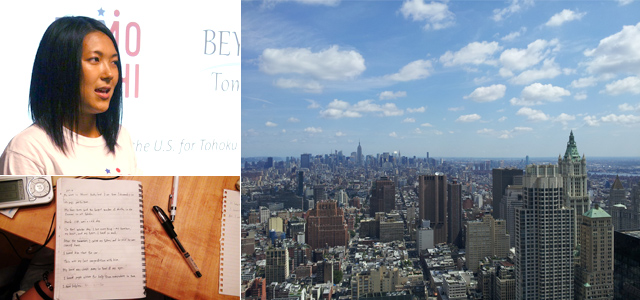
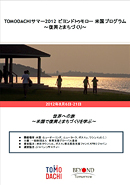 PDF download
PDF download
Overview
 Partnering with the TOMODACHI Initiative, BEYOND Tomorrow undertook “TOMODACHI Summer 2012 BEYOND Tomorrow U.S. Program – Reconstruction and Planning –“ in August 2012. The two-week program in New Orleans, Boston, New York and Washington D.C. aimed to provide students in Tohoku opportunities to learn from the U.S. experience in post-disaster reconstruction and planning and also act as Tohoku ambassadors to share their experiences with American people. Students were chosen through a rigorous selection process and nine students with a proven record of leadership activities and strong aspirations to become future leaders from Tohoku participated in the program.
Partnering with the TOMODACHI Initiative, BEYOND Tomorrow undertook “TOMODACHI Summer 2012 BEYOND Tomorrow U.S. Program – Reconstruction and Planning –“ in August 2012. The two-week program in New Orleans, Boston, New York and Washington D.C. aimed to provide students in Tohoku opportunities to learn from the U.S. experience in post-disaster reconstruction and planning and also act as Tohoku ambassadors to share their experiences with American people. Students were chosen through a rigorous selection process and nine students with a proven record of leadership activities and strong aspirations to become future leaders from Tohoku participated in the program.
Objectives
- To provide opportunities for Japanese students afflicted by the Great East Japan earthquake and tsunami to draw lessons for Tohoku reconstruction from the efforts following 9.11 and Hurricane Katrina by visiting related organizations and experts.
- To have the students act as ambassadors of Tohoku to the American people and develop a model for U.S-Japan leadership exchange in the context of Great East Japan earthquake and tsunami
Dates and Locations
| Orientation Program June 29-July 1, 2012 | Fujiyoshida, Yamanashi, Japan | |
|---|---|---|
| U.S. Program August 6-21, 2012 | New Orleans, Louisiana (August 7-11, 2012) | Itinerary |
| New York, New York (August 11-16, 2012) | Itinerary | |
| Boston, Massachusetts (August 16-19, 2012) | Itinerary | |
| Washington D.C. (August 19-21, 2012) | Itinerary |
New Orleans | Itinerary
August 7, 2012- Arrival in New Orleans
- Tour of Hurricane Katrina Distracted Area
- Center for Hazards, Assessment, Response and Technology (CHART), University of New Orleans (Monica Farris: Director, Center for Hazards, Assessment, Response and Technology (CHART))
- Mary Queen of Vietnam Community Development Corporation, Inc. (Tap Bui: Health Outreach Coordinator, Mary Queen of Vietnam Community Development Corporation, Inc.)
- Market Umbrella (Emery Van Hook: Director of Markets, Market Umbrella
- Reception with Japan Society of New Orleans hosted by Michael Turner (President, Japan Society of New Orleans)
- Ashe Cultural Arts Center (Carol Bebelle: Co-Founder & Executice Director, Ashe Cultural Arts Center)
- Foundation for Louisiana (Christy Wallance Slater: Director of Economic Opportunity, Foundation for Louisiana)
- Mississippi River Cruise Dinner
- Departure to New York
New York | Itinerary
August 11, 2012- Arrival in New York
- Bistro BEYOND in the U.S.
- Exploring New York
- Dialogue with Yutaka Takiura (Associate Professor, Interior Design Department, Pratt Institute)
- 4 World Trade Center (Osamu Sassa: Design, Planning and Development, Maki & Associates)
- Dialogue with Fumi Tosu (Co-President, TABLE FOR TWO USA)
- New York City Economic Development Corporation (Sri Swaminathan: AVP of the International Desk New York City Economic Development Corporation)
- Tribute WTC Visitor Center (Lee Lelpi, President, 9-11 Family Foudation)
- Diner with Stephen Globus in Little Italy
- New York Fire Department (Joseph W. Pfeifer: Chief, New York Fire Department)
- Human Rights Watch (Grace Meng: Researcher, Human Rights Watch)
- Reception by the U.S. Japan Foundation
- Surdna Foundation (Shwan Escoffery: Program Director, Strong Local Economy, Surdna Foundation)
- Dialogue with Motoatsu Sakurai (President, Japan Society)
- Cultural Exchange Program at Japan Society
- Dialogue with Shin Odake (Group Senior Vice President, Fast Retailing Inc. UNIQLO USA CEO )
- Tour of Columbia University by Frederick Katayama (Anchor/ Producer Reuters News Kelley Drye & Warren LLP)
- Barbeque dinner with Japanese American Leaders
- Departure to Boston
Boston | Itinerary
August 16, 2012- Arrival in Boston
- Reception by the Japanese Disaster Relief Fund Boston
- Dialogue with Atsuko Toko Fish (Trustee, Fish Family Foundation)
- Hiroshi Ishii (Associate Director, MIT Media Lab)
- Shun Kanda (Director, MIT Japan 3/11 Initiative, Department of Architecture)
- Cultural Exchange Program with Boston Boys and Girls Club
- Brunch Session with Japanese students studying at MIT or Harvard Business School
- Explore Boston
- Departure to Washington D.C.
Washington D.C. | Itinerary
August 19, 2012- Dinner with the U.S.-Japan Council Members
- Arlington County Fire Department (James Schwartz: Chief, Arlington County Fire Department)
- Washington D.C. Tour
- Courtesy Visit to the Embassy of Japan (Kazuhide Ishikawa, Deputy Chief of Mission. Toshihide Ando, Counselor, Head of the Public Affairs Section, Embassy of Japan in the United States)
- Closing Event: U.S.-Japan Council and BEYOND Tomorrow Joint Program
- Departure to Japan
Participants
10 students who were residents of Iwate, Miyagi or Fukushima at the time of the Great East Japan earthquake and tsunami, and have finished high school or proceeded to higher education by March 2012. All participants were chosen through a rigorous selection process.
Minori Endo
Faculty of Business Administration, Ishinomaki Senshu University (Ishinomakikita High School graduate)
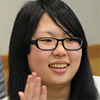 Minori lost her father and her house to the disaster, and though feeling deep despair she wanted for lots of people to be informed about the disaster, and took advantage of her experience as being the editor of a photography department to capture some of the images of the destruction left by the tsunami, sending them out through the media. As someone who experienced the disaster, Minori is motivated to communicate about the “now” of the disaster areas, and in the future she would like to engage in activities that enable her to continue to etch each moment of life into her heart without letting the current “now” get left behind in the past. Through the U.S. program, she would like to develop perspective on Tohoku reconstruction by examining post-disaster reconstructions and planning that took place outside Japan.
Minori lost her father and her house to the disaster, and though feeling deep despair she wanted for lots of people to be informed about the disaster, and took advantage of her experience as being the editor of a photography department to capture some of the images of the destruction left by the tsunami, sending them out through the media. As someone who experienced the disaster, Minori is motivated to communicate about the “now” of the disaster areas, and in the future she would like to engage in activities that enable her to continue to etch each moment of life into her heart without letting the current “now” get left behind in the past. Through the U.S. program, she would like to develop perspective on Tohoku reconstruction by examining post-disaster reconstructions and planning that took place outside Japan.
 Minori lost her father and her house to the disaster, and though feeling deep despair she wanted for lots of people to be informed about the disaster, and took advantage of her experience as being the editor of a photography department to capture some of the images of the destruction left by the tsunami, sending them out through the media. As someone who experienced the disaster, Minori is motivated to communicate about the “now” of the disaster areas, and in the future she would like to engage in activities that enable her to continue to etch each moment of life into her heart without letting the current “now” get left behind in the past. Through the U.S. program, she would like to develop perspective on Tohoku reconstruction by examining post-disaster reconstructions and planning that took place outside Japan.
Minori lost her father and her house to the disaster, and though feeling deep despair she wanted for lots of people to be informed about the disaster, and took advantage of her experience as being the editor of a photography department to capture some of the images of the destruction left by the tsunami, sending them out through the media. As someone who experienced the disaster, Minori is motivated to communicate about the “now” of the disaster areas, and in the future she would like to engage in activities that enable her to continue to etch each moment of life into her heart without letting the current “now” get left behind in the past. Through the U.S. program, she would like to develop perspective on Tohoku reconstruction by examining post-disaster reconstructions and planning that took place outside Japan.
Ayaka Ogawa
Leelanau School, Michigan, U.S.A (Otsuchi High School graduate)
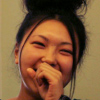 Ayaka lost her parents, her grandparents and her older sister to the tsunami, and now lives in temporary housing with extended family members. As only she was saved and the rest of her family lost, Ayaka would like to try to live life to the fullest and has resolved to fulfill her long-standing interest in studying abroad. Following the disaster, Ayaka also had chance to experience a short-term home stay in Australia. Ayaka feels a great deal of gratitude for the opportunities she has been afforded since the disaster, and so in the future she would like to become someone who also helps others to achieve their hopes. During the U.S. program, she would like to communicate with 9.11 and hurricane victims and would like to know what they are feeling after years of disasters.
Ayaka lost her parents, her grandparents and her older sister to the tsunami, and now lives in temporary housing with extended family members. As only she was saved and the rest of her family lost, Ayaka would like to try to live life to the fullest and has resolved to fulfill her long-standing interest in studying abroad. Following the disaster, Ayaka also had chance to experience a short-term home stay in Australia. Ayaka feels a great deal of gratitude for the opportunities she has been afforded since the disaster, and so in the future she would like to become someone who also helps others to achieve their hopes. During the U.S. program, she would like to communicate with 9.11 and hurricane victims and would like to know what they are feeling after years of disasters.
 Ayaka lost her parents, her grandparents and her older sister to the tsunami, and now lives in temporary housing with extended family members. As only she was saved and the rest of her family lost, Ayaka would like to try to live life to the fullest and has resolved to fulfill her long-standing interest in studying abroad. Following the disaster, Ayaka also had chance to experience a short-term home stay in Australia. Ayaka feels a great deal of gratitude for the opportunities she has been afforded since the disaster, and so in the future she would like to become someone who also helps others to achieve their hopes. During the U.S. program, she would like to communicate with 9.11 and hurricane victims and would like to know what they are feeling after years of disasters.
Ayaka lost her parents, her grandparents and her older sister to the tsunami, and now lives in temporary housing with extended family members. As only she was saved and the rest of her family lost, Ayaka would like to try to live life to the fullest and has resolved to fulfill her long-standing interest in studying abroad. Following the disaster, Ayaka also had chance to experience a short-term home stay in Australia. Ayaka feels a great deal of gratitude for the opportunities she has been afforded since the disaster, and so in the future she would like to become someone who also helps others to achieve their hopes. During the U.S. program, she would like to communicate with 9.11 and hurricane victims and would like to know what they are feeling after years of disasters.
Sakae Onodera
School of Commerce, Waseda University (Sendai Ikuei Gakuen High School graduate)
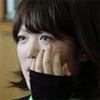 As a result of the disaster Sakae lost her home in Kesennuma. Although the disaster was dreadful Sakae would like to be able to see it as a positive turning point in her own life, and believes that along with her peers who experienced the disaster they should explore things they can do to help, and take positive action in the world in the spirit of “social contribution”. In the future, her dream is to work for an international organization dealing with international development and nation building, as well as international business. During the visit in the U.S., She would like to learn how the U.S. overcame natural disasters and terrorisms, and made improvements in their communities.
As a result of the disaster Sakae lost her home in Kesennuma. Although the disaster was dreadful Sakae would like to be able to see it as a positive turning point in her own life, and believes that along with her peers who experienced the disaster they should explore things they can do to help, and take positive action in the world in the spirit of “social contribution”. In the future, her dream is to work for an international organization dealing with international development and nation building, as well as international business. During the visit in the U.S., She would like to learn how the U.S. overcame natural disasters and terrorisms, and made improvements in their communities.
 As a result of the disaster Sakae lost her home in Kesennuma. Although the disaster was dreadful Sakae would like to be able to see it as a positive turning point in her own life, and believes that along with her peers who experienced the disaster they should explore things they can do to help, and take positive action in the world in the spirit of “social contribution”. In the future, her dream is to work for an international organization dealing with international development and nation building, as well as international business. During the visit in the U.S., She would like to learn how the U.S. overcame natural disasters and terrorisms, and made improvements in their communities.
As a result of the disaster Sakae lost her home in Kesennuma. Although the disaster was dreadful Sakae would like to be able to see it as a positive turning point in her own life, and believes that along with her peers who experienced the disaster they should explore things they can do to help, and take positive action in the world in the spirit of “social contribution”. In the future, her dream is to work for an international organization dealing with international development and nation building, as well as international business. During the visit in the U.S., She would like to learn how the U.S. overcame natural disasters and terrorisms, and made improvements in their communities.
Tomohiro Kamisawa
Faculty of Agriculture, Tohoku University (Morioka First High School graduate)
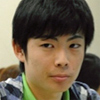 Tomohiro decided to study agriculture, as “agriculture” applies not only to domestic issues in Japan but is important for determining the shape of assistance for solving global problems such as poverty. Rather than just keeping the experience of the disaster inside, Tomohiro would like to make big strides in his personal development along with his friends, while proactively engaging in communication. He hopes to become a person who can give hope to people living in the disaster areas. To this end, Tomohiro would like to study hard at university while participating in BEYOND Tomorrow programs and striving towards his dreams. The trip to the U.S., this time being his first time abroad, he would like to interact with victims of disasters draw lessons of supporting the vulnerable and replicate the learning for Tohoku and the world in the future.
Tomohiro decided to study agriculture, as “agriculture” applies not only to domestic issues in Japan but is important for determining the shape of assistance for solving global problems such as poverty. Rather than just keeping the experience of the disaster inside, Tomohiro would like to make big strides in his personal development along with his friends, while proactively engaging in communication. He hopes to become a person who can give hope to people living in the disaster areas. To this end, Tomohiro would like to study hard at university while participating in BEYOND Tomorrow programs and striving towards his dreams. The trip to the U.S., this time being his first time abroad, he would like to interact with victims of disasters draw lessons of supporting the vulnerable and replicate the learning for Tohoku and the world in the future.
 Tomohiro decided to study agriculture, as “agriculture” applies not only to domestic issues in Japan but is important for determining the shape of assistance for solving global problems such as poverty. Rather than just keeping the experience of the disaster inside, Tomohiro would like to make big strides in his personal development along with his friends, while proactively engaging in communication. He hopes to become a person who can give hope to people living in the disaster areas. To this end, Tomohiro would like to study hard at university while participating in BEYOND Tomorrow programs and striving towards his dreams. The trip to the U.S., this time being his first time abroad, he would like to interact with victims of disasters draw lessons of supporting the vulnerable and replicate the learning for Tohoku and the world in the future.
Tomohiro decided to study agriculture, as “agriculture” applies not only to domestic issues in Japan but is important for determining the shape of assistance for solving global problems such as poverty. Rather than just keeping the experience of the disaster inside, Tomohiro would like to make big strides in his personal development along with his friends, while proactively engaging in communication. He hopes to become a person who can give hope to people living in the disaster areas. To this end, Tomohiro would like to study hard at university while participating in BEYOND Tomorrow programs and striving towards his dreams. The trip to the U.S., this time being his first time abroad, he would like to interact with victims of disasters draw lessons of supporting the vulnerable and replicate the learning for Tohoku and the world in the future.
Masahiro Kikuchi
School of Social and International Studies, Tsukuba University (Takada High School graduate)
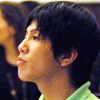 Masahiro lost both his parents in Rikuzentakata. At high school Masahiro demonstrated exceptional leadership as the president of the student council, and after the disaster visited the United Nations headquarters in Europe as part of the 14th High School Peace Ambassador. Masahiro realized the importance of international cooperation after the disaster, and he believes that that communicating the importance of disaster prevention to the rest of the world is a future mission for Japan. In the future, Masahiro would like to become the mayor of Rikuzentakata to lead the way for the recovery of the disaster areas. To address the tough financial situation for many people who lost their jobs, Masahiro wishes to contribute to the resolution of the employment problem. He decided to join the U.S. program to gain global perspectives on reconstruction and urban planning.
Masahiro lost both his parents in Rikuzentakata. At high school Masahiro demonstrated exceptional leadership as the president of the student council, and after the disaster visited the United Nations headquarters in Europe as part of the 14th High School Peace Ambassador. Masahiro realized the importance of international cooperation after the disaster, and he believes that that communicating the importance of disaster prevention to the rest of the world is a future mission for Japan. In the future, Masahiro would like to become the mayor of Rikuzentakata to lead the way for the recovery of the disaster areas. To address the tough financial situation for many people who lost their jobs, Masahiro wishes to contribute to the resolution of the employment problem. He decided to join the U.S. program to gain global perspectives on reconstruction and urban planning.
 Masahiro lost both his parents in Rikuzentakata. At high school Masahiro demonstrated exceptional leadership as the president of the student council, and after the disaster visited the United Nations headquarters in Europe as part of the 14th High School Peace Ambassador. Masahiro realized the importance of international cooperation after the disaster, and he believes that that communicating the importance of disaster prevention to the rest of the world is a future mission for Japan. In the future, Masahiro would like to become the mayor of Rikuzentakata to lead the way for the recovery of the disaster areas. To address the tough financial situation for many people who lost their jobs, Masahiro wishes to contribute to the resolution of the employment problem. He decided to join the U.S. program to gain global perspectives on reconstruction and urban planning.
Masahiro lost both his parents in Rikuzentakata. At high school Masahiro demonstrated exceptional leadership as the president of the student council, and after the disaster visited the United Nations headquarters in Europe as part of the 14th High School Peace Ambassador. Masahiro realized the importance of international cooperation after the disaster, and he believes that that communicating the importance of disaster prevention to the rest of the world is a future mission for Japan. In the future, Masahiro would like to become the mayor of Rikuzentakata to lead the way for the recovery of the disaster areas. To address the tough financial situation for many people who lost their jobs, Masahiro wishes to contribute to the resolution of the employment problem. He decided to join the U.S. program to gain global perspectives on reconstruction and urban planning.
Anna Kumagai
Faculty of Project Design, Miyagi University (Izumi Tateyama High School graduate)
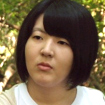 Anna was impressed by the local people’s spirits to help each other even in the midst of disaster. Wanting to give back to the local people, she joined a student organization called “East Japan Challenging & Chance” in which she attempts to help local communities with business. Through the BEYOND Tomorrow U.S. program, she would like to think about what she can do for Tohoku, and learn about successes and failures of the reconstruction activities in the U.S. She believes that the experience in the U.S. will provide her with a framework to plan reconstruction and urban development that are most appropriate for Tohoku.
Anna was impressed by the local people’s spirits to help each other even in the midst of disaster. Wanting to give back to the local people, she joined a student organization called “East Japan Challenging & Chance” in which she attempts to help local communities with business. Through the BEYOND Tomorrow U.S. program, she would like to think about what she can do for Tohoku, and learn about successes and failures of the reconstruction activities in the U.S. She believes that the experience in the U.S. will provide her with a framework to plan reconstruction and urban development that are most appropriate for Tohoku.
 Anna was impressed by the local people’s spirits to help each other even in the midst of disaster. Wanting to give back to the local people, she joined a student organization called “East Japan Challenging & Chance” in which she attempts to help local communities with business. Through the BEYOND Tomorrow U.S. program, she would like to think about what she can do for Tohoku, and learn about successes and failures of the reconstruction activities in the U.S. She believes that the experience in the U.S. will provide her with a framework to plan reconstruction and urban development that are most appropriate for Tohoku.
Anna was impressed by the local people’s spirits to help each other even in the midst of disaster. Wanting to give back to the local people, she joined a student organization called “East Japan Challenging & Chance” in which she attempts to help local communities with business. Through the BEYOND Tomorrow U.S. program, she would like to think about what she can do for Tohoku, and learn about successes and failures of the reconstruction activities in the U.S. She believes that the experience in the U.S. will provide her with a framework to plan reconstruction and urban development that are most appropriate for Tohoku.
Ayaka Goto
Department of Childcare, Miyagi Seishin Junior College (Ishinomaki Commercial High School graduate)
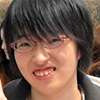 Ayaka was in Ishinomaki when the earthquake and tsunami happened. Though her life was saved, she lost her house only 165 feet from the sea and many of her friends as a result of the tsunami. After the disaster, she had chances to experience homestay in Hawaii and Canada where she saw that the world still praying for Japan and her recovery from the devastation. In the future, she would like to engage in childcare in the developing world such as Africa, and also would like to communicate with people in those countries about the disaster and the importance of disaster prevention. In the U.S., she would like to learn about how the U.S. helped people’s psychological recovery as well as how the cities addressed physical reconstruction activities.
Ayaka was in Ishinomaki when the earthquake and tsunami happened. Though her life was saved, she lost her house only 165 feet from the sea and many of her friends as a result of the tsunami. After the disaster, she had chances to experience homestay in Hawaii and Canada where she saw that the world still praying for Japan and her recovery from the devastation. In the future, she would like to engage in childcare in the developing world such as Africa, and also would like to communicate with people in those countries about the disaster and the importance of disaster prevention. In the U.S., she would like to learn about how the U.S. helped people’s psychological recovery as well as how the cities addressed physical reconstruction activities.
 Ayaka was in Ishinomaki when the earthquake and tsunami happened. Though her life was saved, she lost her house only 165 feet from the sea and many of her friends as a result of the tsunami. After the disaster, she had chances to experience homestay in Hawaii and Canada where she saw that the world still praying for Japan and her recovery from the devastation. In the future, she would like to engage in childcare in the developing world such as Africa, and also would like to communicate with people in those countries about the disaster and the importance of disaster prevention. In the U.S., she would like to learn about how the U.S. helped people’s psychological recovery as well as how the cities addressed physical reconstruction activities.
Ayaka was in Ishinomaki when the earthquake and tsunami happened. Though her life was saved, she lost her house only 165 feet from the sea and many of her friends as a result of the tsunami. After the disaster, she had chances to experience homestay in Hawaii and Canada where she saw that the world still praying for Japan and her recovery from the devastation. In the future, she would like to engage in childcare in the developing world such as Africa, and also would like to communicate with people in those countries about the disaster and the importance of disaster prevention. In the U.S., she would like to learn about how the U.S. helped people’s psychological recovery as well as how the cities addressed physical reconstruction activities.
Tsubasa Sugeno
Faculty of International Studies, Utsunomiya University (Fukushima Technical High School graduate)
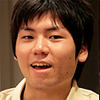 Tsubasa realized the importance of international cooperation after many countries provided support for Japan after the disaster, and decided that he would like to contribute to global society. In order to learn about how to forge a society in which people not just in Japan but from around the world who are suffering due to poverty and conflict can have a reassuring future, Tsubasa decided to study International Relations. While at university Tsubasa also hopes to study abroad, and broaden his horizons. As a victim of the disaster, he would also like to communicate with the rest of the world about the terror of natural disasters and the strength of Tohoku. Through the U.S. program, he would like to take the first step to become an international leader with a creative approach to reconstruction effort and appreciation for diversity.
Tsubasa realized the importance of international cooperation after many countries provided support for Japan after the disaster, and decided that he would like to contribute to global society. In order to learn about how to forge a society in which people not just in Japan but from around the world who are suffering due to poverty and conflict can have a reassuring future, Tsubasa decided to study International Relations. While at university Tsubasa also hopes to study abroad, and broaden his horizons. As a victim of the disaster, he would also like to communicate with the rest of the world about the terror of natural disasters and the strength of Tohoku. Through the U.S. program, he would like to take the first step to become an international leader with a creative approach to reconstruction effort and appreciation for diversity.
 Tsubasa realized the importance of international cooperation after many countries provided support for Japan after the disaster, and decided that he would like to contribute to global society. In order to learn about how to forge a society in which people not just in Japan but from around the world who are suffering due to poverty and conflict can have a reassuring future, Tsubasa decided to study International Relations. While at university Tsubasa also hopes to study abroad, and broaden his horizons. As a victim of the disaster, he would also like to communicate with the rest of the world about the terror of natural disasters and the strength of Tohoku. Through the U.S. program, he would like to take the first step to become an international leader with a creative approach to reconstruction effort and appreciation for diversity.
Tsubasa realized the importance of international cooperation after many countries provided support for Japan after the disaster, and decided that he would like to contribute to global society. In order to learn about how to forge a society in which people not just in Japan but from around the world who are suffering due to poverty and conflict can have a reassuring future, Tsubasa decided to study International Relations. While at university Tsubasa also hopes to study abroad, and broaden his horizons. As a victim of the disaster, he would also like to communicate with the rest of the world about the terror of natural disasters and the strength of Tohoku. Through the U.S. program, he would like to take the first step to become an international leader with a creative approach to reconstruction effort and appreciation for diversity.
Masahide Chiba
Faculty of Engineering, Utsunomiya University (Ofunato High School graduate)
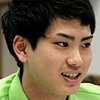 Masahide was in Ofunato when the disaster struck. As a result of the tsunami, he lost his mother, grandmother and home, and is now living in rented accommodation with his father and two younger brothers. Masahide believes that it is his mission to plan towns that are safe from natural disasters and contribute to the future recovery because he survived the devastating disaster when so many lives were lost. Masahide would like to set up a company that carries out projects related with the disaster recovery, and would like to participate in the planning of towns along the Sanriku Coast which are resilient to damage from natural disasters. During the visit to the U.S., he would like examine how the disaster communities in the U.S. recovered from devastation.
Masahide was in Ofunato when the disaster struck. As a result of the tsunami, he lost his mother, grandmother and home, and is now living in rented accommodation with his father and two younger brothers. Masahide believes that it is his mission to plan towns that are safe from natural disasters and contribute to the future recovery because he survived the devastating disaster when so many lives were lost. Masahide would like to set up a company that carries out projects related with the disaster recovery, and would like to participate in the planning of towns along the Sanriku Coast which are resilient to damage from natural disasters. During the visit to the U.S., he would like examine how the disaster communities in the U.S. recovered from devastation.
 Masahide was in Ofunato when the disaster struck. As a result of the tsunami, he lost his mother, grandmother and home, and is now living in rented accommodation with his father and two younger brothers. Masahide believes that it is his mission to plan towns that are safe from natural disasters and contribute to the future recovery because he survived the devastating disaster when so many lives were lost. Masahide would like to set up a company that carries out projects related with the disaster recovery, and would like to participate in the planning of towns along the Sanriku Coast which are resilient to damage from natural disasters. During the visit to the U.S., he would like examine how the disaster communities in the U.S. recovered from devastation.
Masahide was in Ofunato when the disaster struck. As a result of the tsunami, he lost his mother, grandmother and home, and is now living in rented accommodation with his father and two younger brothers. Masahide believes that it is his mission to plan towns that are safe from natural disasters and contribute to the future recovery because he survived the devastating disaster when so many lives were lost. Masahide would like to set up a company that carries out projects related with the disaster recovery, and would like to participate in the planning of towns along the Sanriku Coast which are resilient to damage from natural disasters. During the visit to the U.S., he would like examine how the disaster communities in the U.S. recovered from devastation.
Hiromi Meguro
Faculty of Community Service, Tohoku University of Community Service and Science (Soma Higashi High School graduate)
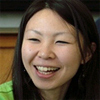 Hiromi was given a lift in the car of a passing stranger while running for her life from the rapidly encroaching tsunami, and it is thanks to this that she barely managed to escape unharmed. Her house was however destroyed, and her father lost his job. Having given up on her dream of attending a university specializing in music and having also considered going straight into employment, eventually Hiromi decided on a new goal of using this scholarship to go on to study town planning and local revitalization in order to contribute to the resources for Tohoku’s recovery. During the stay in the U.S., she would like to learn how the multi-cultural country has integrated diverse population upon reconstruction and urban planning.
Hiromi was given a lift in the car of a passing stranger while running for her life from the rapidly encroaching tsunami, and it is thanks to this that she barely managed to escape unharmed. Her house was however destroyed, and her father lost his job. Having given up on her dream of attending a university specializing in music and having also considered going straight into employment, eventually Hiromi decided on a new goal of using this scholarship to go on to study town planning and local revitalization in order to contribute to the resources for Tohoku’s recovery. During the stay in the U.S., she would like to learn how the multi-cultural country has integrated diverse population upon reconstruction and urban planning.
 Hiromi was given a lift in the car of a passing stranger while running for her life from the rapidly encroaching tsunami, and it is thanks to this that she barely managed to escape unharmed. Her house was however destroyed, and her father lost his job. Having given up on her dream of attending a university specializing in music and having also considered going straight into employment, eventually Hiromi decided on a new goal of using this scholarship to go on to study town planning and local revitalization in order to contribute to the resources for Tohoku’s recovery. During the stay in the U.S., she would like to learn how the multi-cultural country has integrated diverse population upon reconstruction and urban planning.
Hiromi was given a lift in the car of a passing stranger while running for her life from the rapidly encroaching tsunami, and it is thanks to this that she barely managed to escape unharmed. Her house was however destroyed, and her father lost his job. Having given up on her dream of attending a university specializing in music and having also considered going straight into employment, eventually Hiromi decided on a new goal of using this scholarship to go on to study town planning and local revitalization in order to contribute to the resources for Tohoku’s recovery. During the stay in the U.S., she would like to learn how the multi-cultural country has integrated diverse population upon reconstruction and urban planning.
Program Summary
Orientation Program
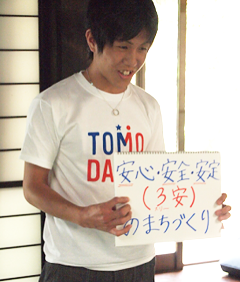 The orientation program took place June 29 – July 1, 2012 at the foot of Mount Fuji. With guest lecturers from the Ministry of Land Use and Planning, the students received hands-on training on the basics of urban planning and reconstruction policies, and based on their own experience, identified issues to be addressed in reconstruction efforts in Tohoku. Divided in two teams, each team developed a presentation on what they would like to learn in the U.S.
(Please see the post-event report for details)
The orientation program took place June 29 – July 1, 2012 at the foot of Mount Fuji. With guest lecturers from the Ministry of Land Use and Planning, the students received hands-on training on the basics of urban planning and reconstruction policies, and based on their own experience, identified issues to be addressed in reconstruction efforts in Tohoku. Divided in two teams, each team developed a presentation on what they would like to learn in the U.S.
(Please see the post-event report for details)
Program in the United States
The program provided participating students with opportunities to learn about post-disaster efforts in the United States, communicate with Japanese leaders who are active internationally, convey messages from Tohoku, and engage in cultural exchange programs with American youths. This comprehensive program enabled students to act as ambassador from Tohoku.a) Learning reconstruction and city planning from post-Katrina and post-9/11 recovery efforts
Students visited a number of individuals and organizations that have been active in post-disaster efforts. These experiences provided students with insight to think about what they would like to bring back to Tohoku for the reconstruction.You have to start with the culture you are in. What works in New Orleans may not work in other cities in the United States. Carol Bebelle, Co-Founder & Executice Director, Ashe Cultural Arts Center
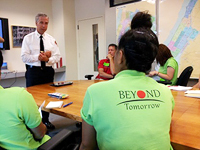
We have a tendency to look back. What we have to do is to look forward. To be courageous is an opportunity that sooner or later is presented to all of us. Joseph W. Pfeifer, Chief, New York City Fire Department
There was a line that I just said today for the first time on my tour. It was ‘I would not be the person today if I didn’t experience the tragedy of 9/11’. It took me longer time to get there than it took to you. But if you can do that, if you can become a stronger and better person because of the tragedy, I think you find the reason to be. A docent who lost her husband on 9.11
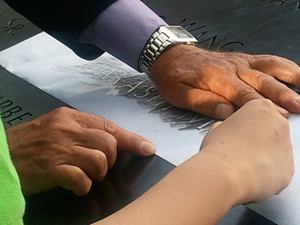
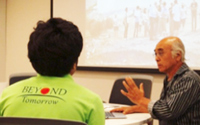
You, the young generation of Tohoku, are the ones who will make the future of Tohoku, and you must be at the forefront Tohoku rebuilding.Shun Kanda (Director, MIT Japan 3/11 Initiative, Department of Architecture)
b) Dialogue with leaders
Students engaged in dialogues with Japanese people from various fields who are active internationally. These opportunities provided students with global perspectives to contribute to society in the future in their fields of passion.If you have opportunities, choose the difficult one that could possibly broaden your perspective. If you are 50% confident, take the chance. There you might find how you can contribute to the society. Particularly young people should go outside Japan as much as possible. Motoatsu Sakurai, President, Japan Society
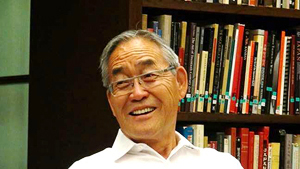
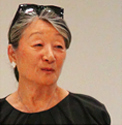
You, the young generation, will make the future of Japan and the world. Leadership is to make your dreams come true and spread it to others. In other words, leadership is about taking control of yourself. Atsuko Toko Fish Trustee, Fish Family Foundation
c) From Tohoku to America – Survivors stories
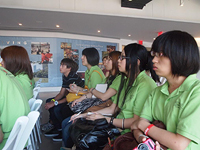 The students delivered presentations to a number of audiences. Presentations included their experiences in the 3/11 earthquake and tsunami, their Tohoku favourites, what they would like to achieve during the program in the U.S., as well as their gratitude to the United States for the support that was given to Tohoku during the disaster.
The students delivered presentations to a number of audiences. Presentations included their experiences in the 3/11 earthquake and tsunami, their Tohoku favourites, what they would like to achieve during the program in the U.S., as well as their gratitude to the United States for the support that was given to Tohoku during the disaster.
 “March 11th was a cold day. On that winter day, I lost everything – my hometown, my house, and my father I loved so much. However, after the disaster, I joined BEYOND Tomorrow and was blessed with new friends who were also suffering the pain. BEYOND Tomorrow brought us together. The past cannot change the present, but the present can change the future. I want to change sadness into strength”
“March 11th was a cold day. On that winter day, I lost everything – my hometown, my house, and my father I loved so much. However, after the disaster, I joined BEYOND Tomorrow and was blessed with new friends who were also suffering the pain. BEYOND Tomorrow brought us together. The past cannot change the present, but the present can change the future. I want to change sadness into strength”
d) Cultural Exchange – Interaction with American students as grassroots ambassadors
The participating students interacted with American students in a leadership exchange between America and Japan. These experiences symbolized the “TOMODACHI generation” – partnership between young Americans and Japanese who will make the future of the two countries and the world.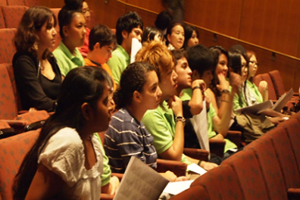 Cultural exchange with high school students in Japan Society Theater Program
Cultural exchange with high school students in Japan Society Theater Program
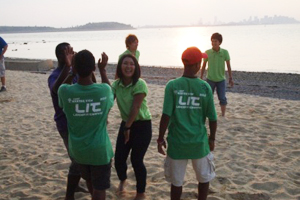 Cultural Exchange program with Boston Boys and Girls Club
Cultural Exchange program with Boston Boys and Girls Club
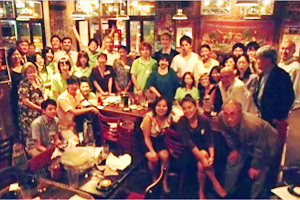 Barbeque Dinner at Harlem with USJC Members
Barbeque Dinner at Harlem with USJC Members
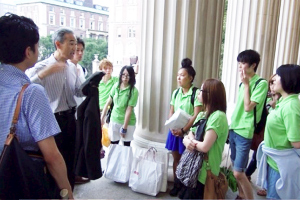 Tour of Columbia University by Mr. Fred Katayama
Tour of Columbia University by Mr. Fred Katayama
Closing event
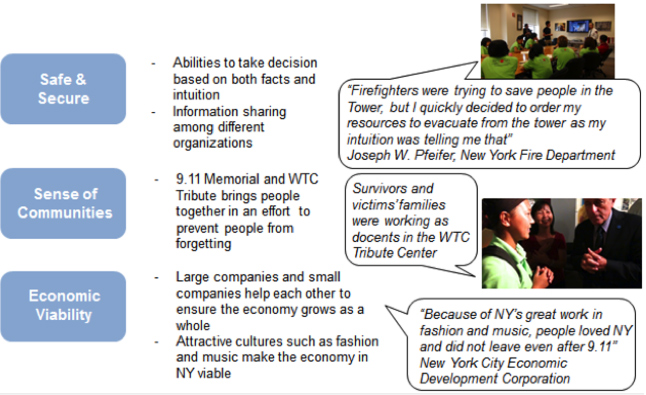 A closing event was organized with the cooperation of the U.S.-Japan Council on August 20, the last day of the trip, in Washington DC. The students presented what they learned in the United States in front of various leaders from areas including the Japanese government, U.S. government, business, non-profit organizations, international organizations, etc.
Please see the slides of the final presentation (PDF)
A closing event was organized with the cooperation of the U.S.-Japan Council on August 20, the last day of the trip, in Washington DC. The students presented what they learned in the United States in front of various leaders from areas including the Japanese government, U.S. government, business, non-profit organizations, international organizations, etc.
Please see the slides of the final presentation (PDF)
Program
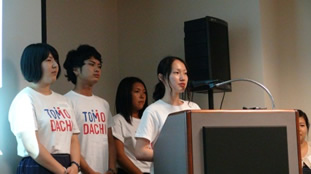 Introductory Remarks from Mr. Neil Horikoshi, President & Executive Director, Asian & Pacific Islander American Scholarship Fund
Introductory Remarks from Mr. Neil Horikoshi, President & Executive Director, Asian & Pacific Islander American Scholarship Fund- Special Remarks from Mr. Koji Tomita, Minister at the Embassy of Japan in the United States of America
- Introduction of BEYOND Tomorrow
- Students Presentation Speeches of student representatives (Ayaka Ogawa, Atsuko Arimoto) What students would like to convey to the United States from Japan What students learned in the United States and what they would like to bring back to Tohoku
Koji Tomita
Minister, Embassy of Japan in the United States of America
I am particularly impressed with this program because it has alarmed all the participants to share the experience , the real experiences, of reconstruction efforts in the various areas in the United States so that they can bring these experiences and expertise to their own efforts, take on the challenge when they go back to their respective local communities.
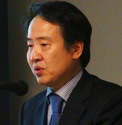
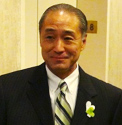
Neil Horikoshi
President & Executive Director, Asian & Pacific Islander American Scholarship Fund
We are proud of your leadership as you embark on your next days, months, and years ahead as you take on to become next leaders for the Tohoku region. We are proud all of you.
Media Coverage
TV
MORNING EYE, FUJISANKEI COMMUNICATIONS INTERNATIONAL, INC. (August 20, 2012)Newspapers
- “Learning Reconstruction in the United States” (August 7, 2012 The Iwate Nippo)
- “Affected Students Interacting with the Bereaved of 9/11” (August 15, 2012 The Fukushima Mimpo)
- “Affected Students’ Determination in NY” (August 15, 2012, Iwate Nippo)
- “3/11 9/11 Each Memory” (August 15, 2012, The Kahoku Shimpo)
- “Final Presentations in Washington D.C.” (August 21, 2012, The Nikkei)
Supporters
Funded by:
 U.S.-Japan Council
U.S.-Japan Council Japanese Disaster Relief Fund – Boston
Japanese Disaster Relief Fund – Boston KPMG Japan
KPMG JapanSupported by:
 Japan Society
Japan Society
